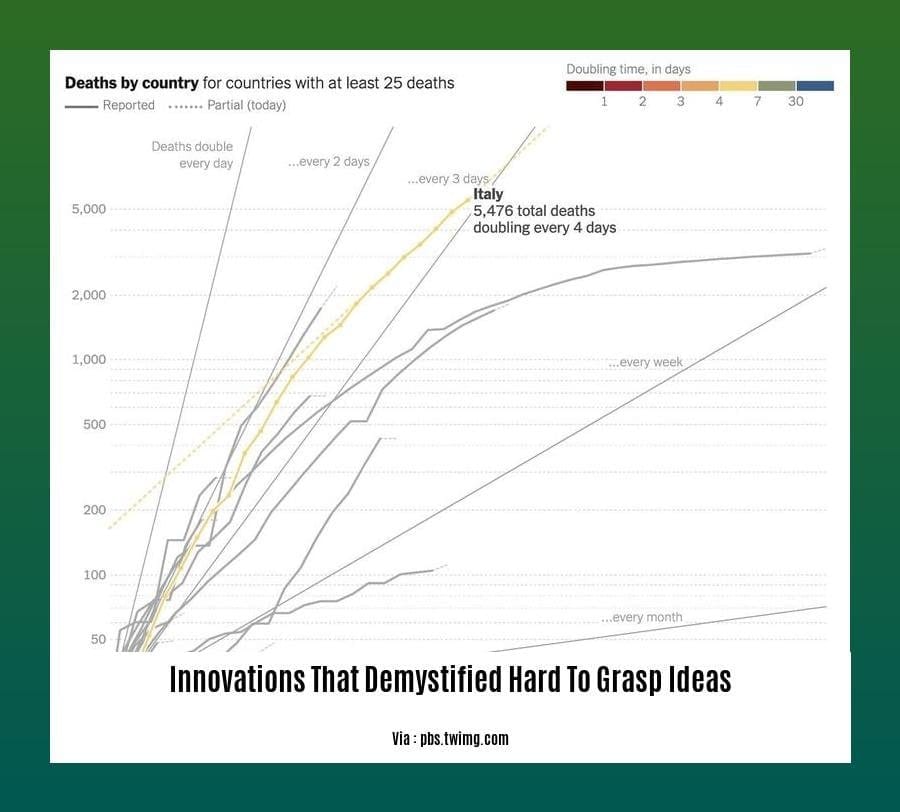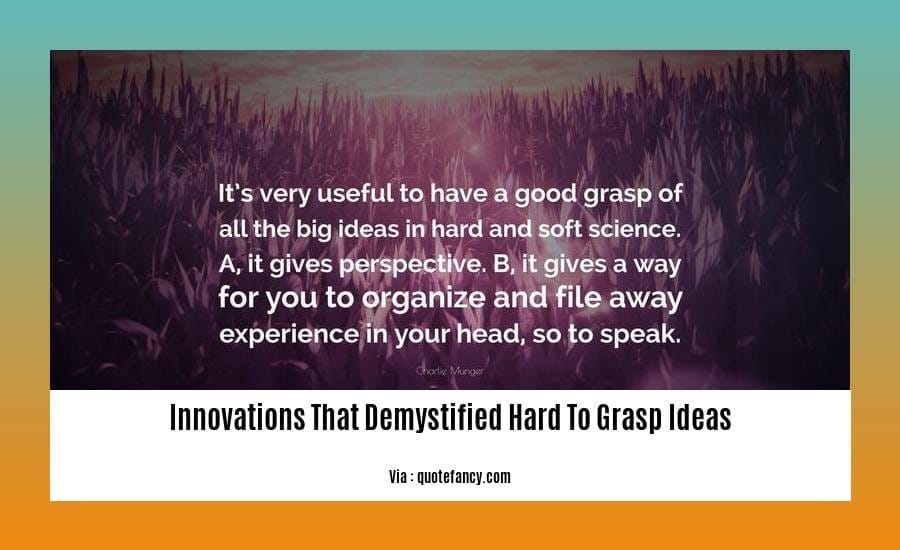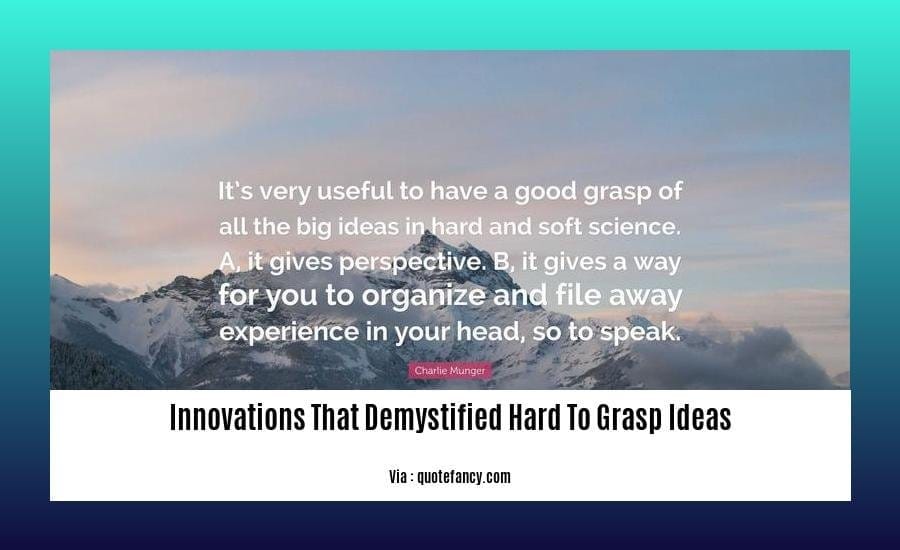Science communication plays a crucial role in bridging the gap between complex scientific advancements and the general public. In recent years, the field has witnessed a surge of innovations that have revolutionized the way we disseminate hard-to-grasp ideas. In this article, we will delve into these innovations, exploring how they have transformed the landscape of science communication and empowered readers to understand the complexities of our world. “Innovations That Demystified Hard-to-Grasp Ideas: Unveiling the Power of Accessible Science Communication” examines the groundbreaking technologies, strategies, and approaches that have made science accessible to all.

Key Takeaways:
- The World Economic Forum has identified 30 innovations that have significantly impacted different industries in the past 30 years.
- The top innovation on the list is not explicitly specified, highlighting the transformative nature of multiple advancements.
- The list showcases the rapid technological and societal progress across various sectors.
- Innovations hold immense potential to enhance lives, address societal concerns, and stimulate economic growth.
Innovations that Demystified Hard-to-Grasp Ideas
Conceptualizing complex ideas can be daunting, hindering comprehension. Fortunately, innovations have emerged to illuminate these concepts, making them more accessible and engaging.
Visualizations
Charts, graphs, and diagrams simplify abstract data into visually digestible formats. By transforming numbers into shapes, colors, and patterns, visualizations enable easy identification of trends, relationships, and patterns.
Simulations and Modeling
Interactive simulations allow users to engage with complex systems and manipulate variables firsthand. This hands-on approach fosters a deeper understanding of cause-and-effect relationships, empowering learners to explore and experiment without real-world consequences.
Gamification
Games transform learning into an enjoyable experience, integrating challenging concepts into fun and engaging gameplay. By incorporating puzzles, challenges, and rewards, gamification promotes active participation, enhances memory retention, and sparks curiosity.
Storytelling and Analogies
Narratives and analogies connect complex ideas to familiar concepts, bridging knowledge gaps. Stories evoke emotions and resonate with experiences, making information more relatable. Analogies simplify abstract concepts by drawing parallels to everyday situations.
Collaborative Learning
Group discussions and peer-to-peer interactions foster collaborative knowledge construction. By sharing perspectives, questioning ideas, and working together, learners gain diverse insights, challenge assumptions, and deepen their understanding.
Get to know the minds behind simplifying the complex. Want to know more about the innovators who simplified complicated concepts? Visit our page to learn more about these talented individuals and their work.
The pioneering minds who made complex things simple made information accessible to all.
Want to know more about the inventors who democratized esoteric knowledge? Visit our page to learn more about these inventors and their contributions to simplifying knowledge.
Gamification
Gamification has brought an exciting spin to the world of knowledge acquisition, transforming learning into an engaging and memorable experience. It seamlessly blends elements of gaming into non-game environments, fostering active participation and boosting information retention.
Key Takeaways:
- Interactive Gameplay: Challenges are presented as puzzles, quests, or simulations, keeping learners engaged and motivated.
- Rewards and Recognition: Points, badges, and leaderboards provide instant gratification, encouraging progress and achievement.
- Social Connections: Collaborative game mechanics promote teamwork, shared learning, and peer support.
- Enhanced Learning: Gamification taps into intrinsic motivation and makes learning enjoyable, leading to deeper understanding and better recall.
- Innovation Catalyst: Gamification’s playful approach fosters creativity and out-of-the-box thinking, driving innovation.
How Gamification Works
- Define Objectives: Establish clear learning goals to guide the game’s design.
- Create a Game Loop: Design a cycle of challenges, rewards, and feedback to maintain engagement.
- Implement Game Mechanics: Use game elements like points, levels, and achievements to motivate and track progress.
- Provide Feedback: Timely feedback helps learners identify weaknesses and encourages improvement.
- Foster Social Interaction: Incorporate multiplayer elements to promote collaboration and knowledge sharing.
Benefits of Gamification
- Increased Engagement: Gamification enhances learner motivation and makes learning more enjoyable.
- Improved Retention: By tapping into intrinsic rewards, gamification promotes better information recall.
- Enhanced Collaboration: Social game mechanics foster teamwork and create a supportive learning environment.
- Boosted Innovation: Gamification encourages experimentation and out-of-the-box thinking, leading to innovative outcomes.
- Measurable Outcomes: Gamification provides quantitative data to track progress and identify areas for improvement.
Example of Gamification in Open Innovation
A popular gamified platform for open innovation, IdeaScale, allows users to submit and vote on ideas. Game mechanics like points, leaderboards, and badges incentivize participation, promote idea refinement, and foster collaboration among users.
Conclusion
Gamification has revolutionized the way we approach complex ideas, making them more accessible, engaging, and memorable. Through its playful approach, gamification empowers learners, fosters innovation, and drives progress in various domains.
Storytelling and Analogies: Tools for Demystifying the Complex
Complex ideas often leave us scratching our heads, but fear not! Cutting-edge innovations are bringing these concepts down to earth, making them as clear as day.
Visualizing the Unseen:
Enter data visualizations. These charts and graphs transform abstract numbers into visually accessible formats, revealing patterns and trends that would otherwise remain hidden.
Simulating Reality:
Simulations and models let you play God with variables. By manipulating these virtual worlds, you gain a deeper understanding of cause-and-effect relationships and how complex systems behave.
Gamifying Learning:
Who says learning has to be boring? Gamification injects games into education, incorporating puzzles and rewards. This approach fuels motivation, improves memory, and makes the whole process more engaging.
The Art of Storytelling and Analogies:
Here’s where the real magic happens. Storytelling and analogies connect complex ideas to familiar concepts, making them instantly relatable. By weaving narratives and drawing parallels, these tools transform foreign subjects into something we can easily grasp.
Collaborative Learning:
Learning doesn’t have to be a solo endeavor. Collaborative discussions and peer interactions encourage questioning, diverse perspectives, and a deeper understanding of complex topics.
Key Takeaways:
- Visualizations: Translate abstract data into digestible visuals.
- Simulations and Modeling: Allow hands-on exploration of complex systems.
- Gamification: Engage learners through game-based challenges.
- *Storytelling and Analogies*: Connect complex ideas to familiar concepts.
- Collaborative Learning: Foster deeper understanding through group discussions.
Citation:
- Gamification-as-Innovation: A Review
Collaborative Learning: Unlocking Deeper Understanding
Collaborative Learning empowers learners to delve deeper into complex ideas through collective discussions and shared perspectives. By harnessing the collective knowledge of peers, students actively engage in critical thinking, problem-solving, and knowledge retention. This collaborative approach fosters creativity, prepares learners for real-world challenges, and enhances overall academic literacy.
Key Takeaways:
- Cultivates Creativity: Collaborative brainstorming stimulates fresh ideas and innovative solutions.
- Readiness for Future Challenges: Cooperative learning prepares students to tackle complex problems in the workplace and beyond.
- Enhances Critical Thinking: Collaborative problem-solving fosters analytical thinking and promotes diverse viewpoints.
- Promotes Academic Literacy: Group discussions and peer interactions improve language proficiency and comprehension.
- Values of Collaboration: Teachers and students highly regard collaborative learning strategies for their educational benefits.
Citation:
The Effectiveness of Collaborative Problem Solving in Promoting Students’ Critical Thinking

FAQ
Q1: How can innovations simplify complex ideas?
A1: Innovations in science communication harness storytelling, analogies, and gamification to break down complex concepts into accessible narratives, making them relatable and engaging for wider audiences.
Q2: Why is demystifying hard-to-grasp ideas important?
A2: Demystifying hard-to-grasp ideas empowers individuals to understand and engage with scientific advancements, promoting informed decision-making and fostering a scientifically literate society.
Q3: What types of innovations have been successful in demystifying complex ideas?
A3: Interactive simulations, immersive visualizations, animated infographics, and gamified learning platforms are among the innovative approaches that have effectively simplified complex scientific concepts.
Q4: How can gamification enhance the process of demystifying complex ideas?
A4: Gamification incorporates game-based elements, such as points, leaderboards, and rewards, to motivate users and make the learning process more engaging and enjoyable, enhancing knowledge absorption and retention.
Q5: What are the benefits of using storytelling in science communication?
A5: Storytelling in science communication helps connect with audiences on an emotional level, making complex ideas relatable and memorable. It fosters empathy, sparks curiosity, and inspires action by weaving scientific facts into compelling narratives.
















